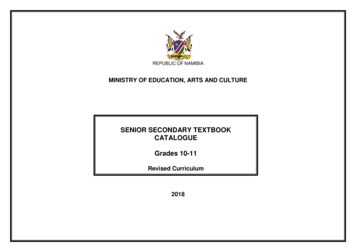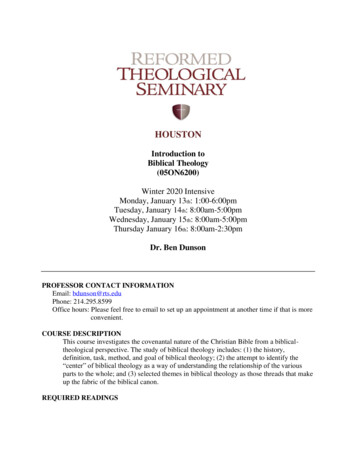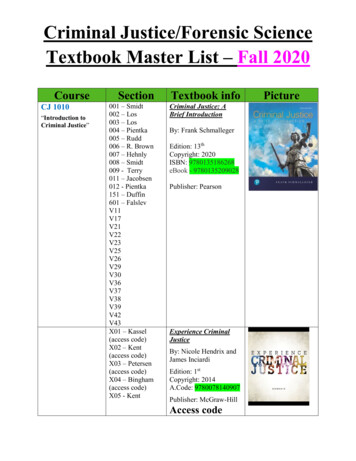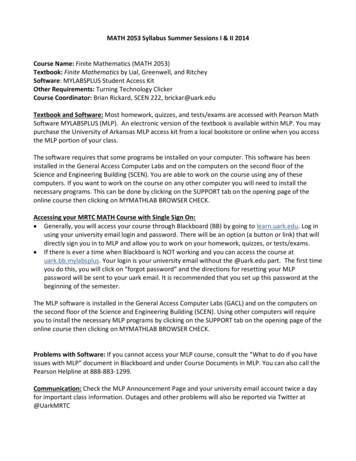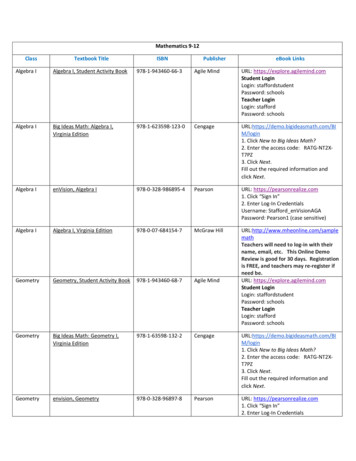
Transcription
21-127HistoryContentComparisonEndTextbook and course materials for 21-127Concepts of MathematicsThesis defense, D.A. in Mathematical SciencesBrendan W. SullivanCarnegie Mellon UniversityMay 8, 2013Brendan W. SullivanCarnegie Mellon UniversityTextbook and course materials for 21-127 Concepts of Mathematics
21-127HistoryContentComparisonEndAbstractConcepts of Mathematics (21-127 at CMU) is a course designed tointroduce students to the world of abstract mathematics, guiding themfrom more calculation-based math (that one might learn in highschool) to higher mathematics, which focuses more on abstractthinking, problem solving, and writing proofs. This transition tendsto be a shock: new notation, terminology, and expectations(particularly the requirement of writing mathematical thoughtsformally) give students much trouble. Many standard texts for thiscourse are found to be too dense, dry and formal by the students.Ultimately, this means these texts are unhelpful for student learning,despite their intentions. For this project, I have written a newtextbook designed specifically for this course and the way it has beentaught. My emphases—writing more informal prose, properlymotivating all new material, and including a wider variety of exercisesand questions for the reader—all reflect the goal of increasing thereader’s interest and potential for learning. I have also includedaccompanying class notes, meant to supplement the teaching of thiscourse, as well as assignments and exams, and their correspondingsolutions and grading rubrics.Brendan W. SullivanCarnegie Mellon UniversityTextbook and course materials for 21-127 Concepts of Mathematics
his is joint work with Profs. John Mackey and Jack Schaeffer.Thanks to John, Jack, Bill, and Hilary for guidance.Thanks to all of you for attending.Brendan W. SullivanCarnegie Mellon UniversityTextbook and course materials for 21-127 Concepts of Mathematics
21-127HistoryContent1 Concepts of Math 21-127Course GoalsContent2 Project HistoryTimelineRetrospective3 Outline of Project ContentChaptersStyleExercisesBrendan W. SullivanComparisonEndSupplements4 Comparison to ExtantTextsPositivesNegativesNovelties5 Summary & ConclusionsEnd ResultsFuture WorkReferencesCarnegie Mellon UniversityTextbook and course materials for 21-127 Concepts of Mathematics
21-127HistoryContentComparisonEndCourse description21-127 Concepts of MathematicsAll Semesters: 10 unitsThis course introduces the basic concepts, ideas and toolsinvolved in doing mathematics. As such, its main focus is onpresenting informal logic, and the methods of mathematicalproof. These subjects are closely related to the application ofmathematics in many areas, particularly computer science.Topics discussed include a basic introduction to elementarynumber theory, induction, the algebra of sets, relations,equivalence relations, congruences, partitions, and functions,including injections, surjections, and bijections. A prerequisitefor 15-211. (3 hrs. lec., 2 hrs. s/Brendan W. SullivanCarnegie Mellon UniversityTextbook and course materials for 21-127 Concepts of Mathematics
21-127HistoryContentComparisonEndCourse GoalsTransition from computation to proofHigh school math courses emphasize formulaic, roteapplication of methods: “Follow this example”.Even college calculus is focused on getting the right answerby standard techniques: “Plug and chug”.This is not what mathematics is truly about!We want students to be able to think abstractly,understand and generalize methods, explore variousproblem-solving techniques, and ultimately write proofs.This is a difficult transition for the students, and places aburden on the instructor and TAs.Brendan W. SullivanCarnegie Mellon UniversityTextbook and course materials for 21-127 Concepts of Mathematics
21-127HistoryContentComparisonEndCourse GoalsWho takes this course, and why?All years, but mostly freshmen/sophomores.(Have had grads and advanced high-schoolers, too.)All majors, but mostly MCS and CIT.Pre-req for most higher math courses.Required for math majors.Co-req for ECE 18-240.Pre-req for CS 15-150, co-req for 15-122.AP/EA students who want to break the “calculus cycle”.From our perspective: We want students to understandwhat math really is and what mathematicians do.Reputation: Challenging but rewarding course. Somestudents take it several times.Brendan W. SullivanCarnegie Mellon UniversityTextbook and course materials for 21-127 Concepts of Mathematics
21-127HistoryContentComparisonEndContentMaterial covered“Topics discussed include a basic introduction to elementary number theory,induction, the algebra of sets, relations, equivalence relations, congruences,partitions, and functions, including injections, surjections, and bijections.”(“The easier it sounds, the harder it is.”)This allows for some variability, by instructor.Main goal is to introduce proof methods and illustratethem by exploring different topics.Certain fundamental topics need to be introduced here sothat students are familiar with them later, e.g. induction,sets, functions.Other topics can be chosen and developed based on interestor timing, e.g. cardinality, number theory, probability.Brendan W. SullivanCarnegie Mellon UniversityTextbook and course materials for 21-127 Concepts of Mathematics
21-127HistoryContentComparisonEndContentSequencing of material(1) Mathematical arguments(8) Modular arithmetic(2) Induction(9) Number theory(3) Sets(10) Functions(4) Formal logic(11) Cardinality(5) Proof techniques(12) Combinatorics(6) Relations(13) Probability(7) Equivalence classes(14) Basic graph theoryThese can be reordered and/or dropped in some ways, but thetopics in the left column should precede those on the right.Timing of the semester and pace of the course affects the levelof detail of included topics, as well.Brendan W. SullivanCarnegie Mellon UniversityTextbook and course materials for 21-127 Concepts of Mathematics
on and assessment10 written assignmentsThree 1-hr lectures, MWFLed by instructor, introducesnew material and examples.Two 1-hr recitations, TRLed by TAs, work onproblem-solving andconceptual help.Brendan W. SullivanEmphasis on solvingproblems and writing proofs.3 in-class examsEmphasis on content recalland writing proof detailsquickly (“time crunch”).1 finalEmphasis on synthesizingcourse content and applyingmethods to write proofsacross areas.Carnegie Mellon UniversityTextbook and course materials for 21-127 Concepts of Mathematics
21-127HistoryContentComparisonEndGenesis and motivationServed as TA for 21-127. Found myself agreeing with somestudents’ complaints about the standard text. Starteddeveloping ways to work around these conditions to presentbetter material and help student learning.Was looking for a project to devote myself to. Realized Iwas very interested in teaching and already felt motivatedto spend lots of time on course design and materials.Recognized how important this course is to the mathcurriculum, in general. Wished I had such a course in myundergrad education.Brendan W. SullivanCarnegie Mellon UniversityTextbook and course materials for 21-127 Concepts of Mathematics
all 2010 — TASummer I 2011 — graderSummer II 2011 — instructorFall 2011 — TA (w/ Mackey)Summer 2012 — instructorFall 2012 — instructor (w/ Schaeffer)While not teaching, writing!Brendan W. SullivanCarnegie Mellon UniversityTextbook and course materials for 21-127 Concepts of Mathematics
ring 2011 — Began writing with Mackey. First three chapterstook shape. Stated goals and developed rough plan for the rest.Editing and guidance from Mackey based on his experience.Summer 2011 — Used new materials to supplement standardtext while instructing. Focused on finding good motivatingexamples for material, as well as writing exercises to “field test”.Fall 2011 — Spent much time helping with logistics of course,including grading (and verifications) and student help. Wrote“recitation sheets” whose content has been repurposed. Also usedsome of my written problems on homeworks.Spring 2012 — Wrote most of the later chapters. Still decidingwhat to include/omit and how to sequence the material.Brendan W. SullivanCarnegie Mellon UniversityTextbook and course materials for 21-127 Concepts of Mathematics
mmer 2012 — Used solely my materials while instructing.Large summer class with many AP/EA students. Realized thatgreater emphasis on proof techniques is needed. Wrote lecturenotes and developed many examples and exercises to be used.Fall 2012 — Used my materials and collaborated with Prof.Schaeffer on assignments/exams. Further developed lecture andrecitation notes, and exercises, which were very useful in finishingthe writing of the book and providing supplemental materials.Spring 2013 — Took teaching experiences and written materialsand finished writing book. Decided on sequencing, examples andexercises. Standardized formatting and chapter structures,created many diagrams.Brendan W. SullivanCarnegie Mellon UniversityTextbook and course materials for 21-127 Concepts of Mathematics
se/book tensionMuch of this project developed around my simultaneousteaching of the course, in various settings.Good:Ability to “field test” examples, explanations and exercises.Instant feedback from students on materials, andgiven-and-take from me (via AnnotateMyPDF).Bad:Had hopes for extra material that was not approached dueto time/space constraints.Might limit appeal of the book to outside sources, or evenother instructors.Brendan W. SullivanCarnegie Mellon UniversityTextbook and course materials for 21-127 Concepts of Mathematics
book/informality tensionAs described later, one major goal is to write less formally thanother texts to engage the reader.Good:This idea developed from direct experiences with students,and it seemed like this is what they wanted (or wouldunknowingly benefit from).Makes the book stand out amongst others; non-standardfor a math book designed for budding math-doers.Bad:Might “turn off” especially rigorous students who werealready motivated to pursue higher mathematics.Length and “wordiness” can be overwhelming.Brendan W. SullivanCarnegie Mellon UniversityTextbook and course materials for 21-127 Concepts of Mathematics
21-127HistoryContentComparisonEndOverall structure of bookPart I: Learning to Think MathematicallyIntroduction to mathematical arguments (What is a proof?)including inductive argumentsSets as fundamental objects, new definitions and notationLogic and proof techniques (central focus)Return to induction, formalization and further developmentPart II: Learning Mathematical TopicsApplying proof techniques to other topics while usingproblem-solving skills and gathering knowledgeRelations and properties, equivalence relations and classes,modular arithmetic, number theoryFunctions and properties, cardinality, infinite setsCombinatorics, basic counting arguments, counting in twoways, intro to advanced topics(See other handout, TOC)Brendan W. SullivanCarnegie Mellon UniversityTextbook and course materials for 21-127 Concepts of Mathematics
21-127HistoryContentComparisonEndChaptersPart I1. What is Mathematics?2. Mathematical Induction: “And so on . . . ”3. Sets: Mathematical Foundations4. Logic: The Mathematical Language5. Rigorous Mathematical Induction: A Formal RestatementBrendan W. SullivanCarnegie Mellon UniversityTextbook and course materials for 21-127 Concepts of Mathematics
21-127HistoryContentComparisonEndChaptersPart II6. Relations and Modular Arithmetic: Structuring Sets andProving Facts About The Integers7. Functions and Cardinality: Inputs, Outputs, and The Sizesof Sets8. Combinatorics: Counting StuffBrendan W. SullivanCarnegie Mellon UniversityTextbook and course materials for 21-127 Concepts of Mathematics
21-127HistoryContentComparisonEndChapters1. What is Mathematics?1.1 Present four “proofs” of the Pythagorean theorem.Discuss prime numbers and the infinitude of primes.Argue there exist irrational a, b such that ab is rational.1.2 Discuss importance of notation and definitions.Informally discuss logic and show bad/incorrect proofs.Dicuss some history and preview chapter on logic.1.3 Describe presumed knowledge: familiarity with arithmeticand high-school level algebra (showing practice examples).Solve systems of equations, derive Quadratic Formula.Discuss standard sets of numbers, preview chapter on sets.Brendan W. SullivanCarnegie Mellon UniversityTextbook and course materials for 21-127 Concepts of Mathematics
21-127HistoryContentComparisonEndChapters1. What is Mathematics?1.4 Present four interesting puzzles. Thoroughly discusssolutions, as well as how to approach them. Summarize eachwith a lesson.The Missing Dollar ProblemGauss’ Sum: 1 2 3 · · · n n(n 1)2Sum of odds: 1 3 5 · · · (2n 1) n2Monty Hall Problem1.5 Exercises: Algebraic problems, simple puzzles that requiresome ingenuity, practice with definitions and notation.1.6 Lookahead: Focus on the sum puzzles, inductive arguments.Brendan W. SullivanCarnegie Mellon UniversityTextbook and course materials for 21-127 Concepts of Mathematics
21-127HistoryContentComparisonEndChapters2. Mathematical Induction2.1 Intro: objectives, segue, motivation, goals and warnings.P 22.2 Examples of “regular induction”:k and lines on a plane2.3 Domino Analogy (and others), an informal discussion2.4 Examples of “strong induction”: Fibonacci tilings and“Takeaway” (basic Nim, handout 1, p. 131)2.5 Applications: recursive programming, Tower of Hanoi2.6 Summary2.7 Exercises: inductive arguments, guiding through inductionproofs, discovery of formulae, several “spoofs”2.8 Lookahead: develop the fundamentals to be more rigorousBrendan W. SullivanCarnegie Mellon UniversityTextbook and course materials for 21-127 Concepts of Mathematics
21-127HistoryContentComparisonEndChapters3. Sets3.1 Intro: objectives, segue, motivation, goals and warnings.3.2 Main idea: examples from everyday life and math3.3 Definition and examples: proper notation, set-builder usage,empty set, Russell’s Paradox (and a brief note on axioms)3.4 Subsets: definition and standard examples, finding thepower set, equality by containment, the “bag analogy”3.5 Set operations: , , , A (handout 4, p. 174)3.6 Indexed sets: notation, usage, examples, operations3.7 Cartesian products: ordered pairs, examples3.8 [Optional] Defining N via sets: inductive sets, state PMIBrendan W. SullivanCarnegie Mellon UniversityTextbook and course materials for 21-127 Concepts of Mathematics
21-127HistoryContentComparisonEndChapters3. Sets3.9 Proofs involving sets:Introduces idea of appealing to formal definitions.How to prove Double-containment proofs to show Many examples, including indexed operationsDisproving claims (introduces logical negation gently)3.10 Summary3.11 Exercises: practice with notation and reading statements,asks reader to provide examples and non-examples, several“spoofs”, proofs involving sets (avoiding arguments thatwould be made easier via logic, e.g. DeMorgan’s Laws)3.12 Lookahead: logical ideas, develop proof techniques to applyBrendan W. SullivanCarnegie Mellon UniversityTextbook and course materials for 21-127 Concepts of Mathematics
21-127HistoryContentComparisonEndChapters4. Logic4.1 Intro: objectives, segue, motivation, goals and warnings.4.2 Mathematical statements: variable propositions, examplesand non-examples, proper notation4.3 Quantifiers: usage and notation, how to read and writestatements, “fixed” variables4.4 Negating quantifiers: method and examples, Law of theExcluded Middle, redefine indexed set operations4.5 Connectives: , , , Many examples and non-examples of each, in-depthdiscussion of and various forms, redefine set operationsBrendan W. SullivanCarnegie Mellon UniversityTextbook and course materials for 21-127 Concepts of Mathematics
21-127HistoryContentComparisonEndChapters4. Logic4.6 Logical equivalence: definition and usage and examples,biconditionals, necessary/sufficient, associative/distributivelaws, DeMorgan’s Laws, (double-)containment proofs4.7 Logical negations: use DeMorgan’s Laws, negatingP Q, method and examples4.8 [Optional] Truth sets: relating connectives to sets4.9 Proof strategies: major focus, outline direct/indirect/othermethods for each connective, implement an exampleshowing necessary scratch work (handout 3, p. 286)4.10 Summary4.11 Exercises: applying proof techniques, discovering truths4.12 Lookahead: have learned ideas to revisit inductionBrendan W. SullivanCarnegie Mellon UniversityTextbook and course materials for 21-127 Concepts of Mathematics
21-127HistoryContentComparisonEndChapters5. Formal Mathematical Induction5.1 Intro: objectives.5.2 Regular induction: state and prove PMI, provide prooftemplate and illustrate usage, emphasize common errors5.3 Variants: different base case, backwards, evens/odds5.4 Strong induction: state and prove PSMI, provide prooftemplate and illustrate usage, compare to PMI5.5 Variants: “minimal criminal”, WOP, TFAE5.6 Summary5.7 Exercises: more difficult arguments, prove WOP, “spoofs”5.8 Lookahead: new goal, functionsThis concludes Part I (just over halfway).Brendan W. SullivanCarnegie Mellon UniversityTextbook and course materials for 21-127 Concepts of Mathematics
21-127HistoryContentComparisonEndChapters6. Relations and Modular Arithmetic6.1 Intro: objectives, segue, motivation, goals and warnings.6.2 Binary relations: definition and examples, properties(reflexive, symmetric, transitive, anti-symmetric) andcanonical examples, proving/disproving properties6.3 [Optional] Order relations: posets, tosets, chains, (toinclude: well orders)6.4 Equivalence relations: examples and motivation, equivalenceclasses and how to characterize them, partitions, theorems(some proofs as exercises)Brendan W. SullivanCarnegie Mellon UniversityTextbook and course materials for 21-127 Concepts of Mathematics
21-127HistoryContentComparisonEndChapters6. Relations and Modular Arithmetic6.5 Modular arithmetic: equivalence classes mod n, using modsto prove facts, multiplicative inverses (relatively prime),solving Diophantine equations, CRT, Bézout6.6 Summary6.7 Exercises: proving properties of relations, characterizingequivalence classes, solving number theory claims, provinginteresting lemmas and theorems, some “spoofs”6.8 Lookahead: a function is a relationBrendan W. SullivanCarnegie Mellon UniversityTextbook and course materials for 21-127 Concepts of Mathematics
21-127HistoryContentComparisonEndChapters7. Functions and Cardinality7.1 Intro: objectives, segue, motivation, goals and warnings.7.2 Definition and examples: “well-defined”, functional equality,schematics, breaking idea that it’s a “rule” on numbers7.3 Images and pre-images: definitions and easy/hard examples,proof strategies (reiterate sets and logic), constructingcounterexamples (handout 2, p. 488)7.4 Properties: “jections”, definitions and examples, proofstrategies, how to determine properties7.5 Compositions and inverses: notation and usage andexamples, proving inverse by composing both ways to getidentity, bijection iff invertibleBrendan W. SullivanCarnegie Mellon UniversityTextbook and course materials for 21-127 Concepts of Mathematics
21-127HistoryContentComparisonEndChapters7. Functions and Cardinality7.6 Cardinality: finite vs. infinite, comparing via functions(discussion on axioms/defns), Cantor’s Theorem, countablyinfinite sets (Hilbert Hotel, examples and theorems, infinitevs. arbitrarily large), uncountably infinite sets (examplesand theorems, levels of infinity)7.7 Summary7.8 Exercises: wide range of difficulties, many lemmas fromchapter, exploring properties, prove/find counterexample,“spoofs”, sets of binary strings (handout 5, p. 556)7.9 Lookahead: focus on finite setsBrendan W. SullivanCarnegie Mellon UniversityTextbook and course materials for 21-127 Concepts of Mathematics
21-127HistoryContentComparisonEndChapters8. Combinatorics8.1 Intro: objectives, segue, motivation, goals and warnings.8.2 Basic counting principles: Rules of Sum and Product,fundamental objects and formulae (permutations, selections,binomial coefficients, arrangements), relation to functions8.3 Counting arguments: combining ROS/ROP, case analysis,decision processes, being careful of under/overcounts, otherobjects (n-tuples, alphabets, anagrams, lattice paths)8.4 Counting in two ways: method summary, examples,theorems and uses, how to analyze an identity and constructan argument8.5 Selections with repetition: Pirates & Gold (stars & bars),balls in bins, indistinguishable dice, examplesBrendan W. SullivanCarnegie Mellon UniversityTextbook and course materials for 21-127 Concepts of Mathematics
21-127HistoryContentComparisonEndChapters8. Combinatorics8.6 Pigeonhole: statement and proof (logic), examples8.7 Inclusion/Exclusion: statement and proof, examples whereintersections have fixed size, other examples (sels. w/rep.)8.8 Summary8.9 Exercises: wide variety of difficulties, many counting in twoways, some “spoofs” to identiy over/undercounts, Fermat’sLittle via binomial coeffs, comparing selections with andw/o repetition8.10 Lookahead: go forth and prosperBrendan W. SullivanCarnegie Mellon UniversityTextbook and course materials for 21-127 Concepts of Mathematics
efinitions and TheoremsSeparated by topic (not necessarily chronology)Proof strategies for connectives, functions, inductionCardinality catalogAcronyms and phrasesHelpful reference (suggested by students)Brendan W. SullivanCarnegie Mellon UniversityTextbook and course materials for 21-127 Concepts of Mathematics
21-127HistoryContentComparisonEndStyleProse: readable, engaging, but meaningfulSee handout 1, p. 131-134.Encourage reader to explore the concepts and examples ontheir own. Ask insightful questions to guide them.Present motivation and analysis as if in the role of aknowledgeable fellow student, but backed by expert insight.Admittedly, writing looks “texty” but this is broken up bysection headings, itemized lists, diagrams, and questions.Encouraging the reader: we are on the same journey.Written as if I were speaking in the classroom, but benefitsfrom organization and foresight.Not an informational reference necessarily, but a conceptualreference. (Where else can students find fully explained andmotivated theorems and examples?)Brendan W. SullivanCarnegie Mellon UniversityTextbook and course materials for 21-127 Concepts of Mathematics
21-127HistoryContentComparisonEndStyleInformation: avoiding “expert blind-spots”See handout 2, p. 488-491.Mathematical writing tends to treat the reader as a fellowexpert, with no mention of work “behind the scenes”.“We often skip or combine critical steps when we teach. Students, on theother hand, don’t yet have sufficient background and experience to makethese leaps and can become confused, draw incorrect conclusions, or fail todevelop important skills. They need instructors to break tasks intocomponent steps, explain connections explicitly, and model processes indetail.”Eberly Center: mlSomewhat like the “follow this example” method butemphasizes critical thinking, not a rote algorithm.See handout 3, p. 286-291 for a combo of these approaches.Brendan W. SullivanCarnegie Mellon UniversityTextbook and course materials for 21-127 Concepts of Mathematics
21-127HistoryContentComparisonEndStyleConsistency of chapter structuresEach chapter has the following outline:Introduction:ObjectivesSegue from previous chapterMotivationGoals and warnings for the readerSections:ContentQuestions: Remind YourselfExercises: Try ItConclusion:SummaryChapter exercisesLookaheadBrendan W. SullivanCarnegie Mellon UniversityTextbook and course materials for 21-127 Concepts of Mathematics
21-127HistoryContentComparisonEndStyleConsistency of chapter structuresExample of objectives (from Chapter 8: Combinatorics):By the end of this chapter, you should be able to . . .State the Rules of Sum and Product, and use and combine them toconstruct simple counting arguments.Categorize several standard counting objects, as well as state correspondingcounting formulas and understand how to prove them.Understand the meaning of binomial coefficients, how to use them incounting arguments, and how to derive their numerical formula.Critique a proposed counting argument by properly demonstrating if it is anundercount or overcount.Prove combinatorial identities by constructing “counting in two ways” proofs.Understand various formulations of selection with repetition, and use themto solve problems.State the Pigeonhole Principle and use it in counting arguments.State the Principle of Inclusion/Exclusion and use it in counting arguments.Brendan W. SullivanCarnegie Mellon UniversityTextbook and course materials for 21-127 Concepts of Mathematics
21-127HistoryContentComparisonEndExercisesSection exercises: easy concept checksSee handout 4, p. 174-175Questions: Remind YourselfChecking the ability to recall a definition or theorem, useproper notation, identify the difference between twoconcepts, name canonical examples/non-examples.Exercises: Try ItRequire some more thought/effort but are not meant to betoo challenging. Reminds the reader they need to do math.Together, summarizing and reinforcing main ideas from thesection. Building up understanding to move on with morecontent. Easing into more difficult chapter exercises.Brendan W. SullivanCarnegie Mellon UniversityTextbook and course materials for 21-127 Concepts of Mathematics
21-127HistoryContentComparisonEndExercisesChapter exercises: variety and synthesisSee handout 5, p. 556-565.Combines material from that chapter and all previous.Problems range widely in difficulty. (Typically, easiest onescome first; remainder are spread out.)Easy problems can amount to understanding definitionsand notation.Always features a few “spoofs”: find the flaw (if any!) in aproposed argument. Essential mathematical skill.Often asks reader to prove lemmas/theorems we stated.Several prove/disprove problems.Some difficult problems scaffolded to guide the reader (e.g.7.8.30, p. 561, structured double induction).Various hints and suggestions.Brendan W. SullivanCarnegie Mellon UniversityTextbook and course materials for 21-127 Concepts of Mathematics
21-127HistoryContentComparisonEndSupplementsClass notesLecture notes:Condensed versions of definitions and examples, with somediscussion. Some new examples and questions.Helpful for instructor to set pace/timing of course.Helpful for student to have (perhaps) more digestible notes.Recitation notes:Extra examples and exercises to work through.Supplements course material with problems that wouldn’tsqueeze into a lecture (time/content).(Two versions: one for TA notes, one for student handout.)Helpful for instructor/TAs to have suggested problems.Helpful for student to have written record of (often)predominantly verbal problem-solving sessions.Brendan W. SullivanCarnegie Mellon UniversityTextbook and course materials for 21-127 Concepts of Mathematics
rks and examsMost homework problems appear in book.Helpful for instructor to have identified set of problems thatare especially fruitful for students to work on.Most exam problems do not appear in book.Helpful for instructor to see what can feasibly be completedin 50 minutes. Exams carefully designed to minimize timecrunch (Prep Questions) and address all required skills(concepts, read math, problem-solve, write proofs).Solutions and rubrics included.Helpful for student to have fully detailed examples of goodproofs. Need role models.Helpful for instructor/TAs to have indication of what isimportant in a solution (based on common errors).Brendan W. SullivanCarnegie Mellon UniversityTextbook and course materials for 21-127 Concepts of Mathematics
21-127HistoryContentComparisonEndWhy bother?Aren’t there many books/courses that do this?I knew there could be a better book, one that would be morehelpful for students and would bring more of them into the worldof mathematics. (In particular, I wish I’d had such a book.)“The D.A. thesis . . . [is expected] to demonstrate an ability to organize, understand, andpresent mathematical ideas in a scholarly way, usually with sufficient originality and worth toproduce publishable m.htmlBrendan W. SullivanCarnegie Mellon UniversityTextbook and course materials for 21-127 Concepts of Mathematics
s teaching principlesEffective teaching involves . . tml. . . acquiring relevant knowledge about students and usingthat knowledge to inform our course design and classroomteaching. . . articulating explicit expectations regarding learningobjectives and policies. . . prioritizing the knowledge and skills we choose to focuson. (“Coverage is the enemy.”). . . recognizing and overcoming our expert blind spots. . . adopting appropriate teaching roles to support ourlearning goals.Brendan W. SullivanCarnegie Mellon UniversityTextbook and course materials for 21-127 Concepts of Mathematics
21-127HistoryContentComparisonEndPositivesMade from experience and trialMuch of the content was developed first in recitations,seeing where students needed more/fewer examples,more/less illust
Textbook and course materials for 21-127 Concepts of Mathematics. 21-127 History Content Comparison End Acknowledgements ThisisjointworkwithProfs. JohnMackeyandJackSchaeffer. . Textbook and course materials for 21-127 Concepts of Ma



